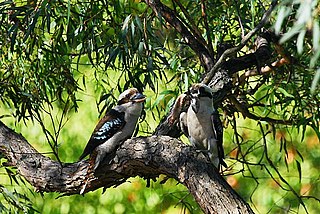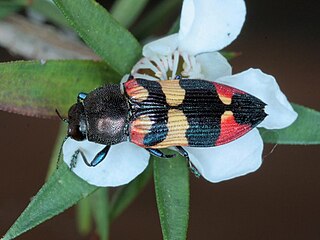
Buprestidae is a family of beetles known as jewel beetles or metallic wood-boring beetles because of their glossy iridescent colors. Larvae of this family are known as flatheaded borers. The family is among the largest of the beetles, with some 15,500 species known in 775 genera. In addition, almost 100 fossil species have been described.
The family Archeocrypticidae is a small group of beetles with no vernacular common name, though recent authors have coined the name cryptic fungus beetles. Adults and larvae seems to be saprophagous and are often found in plant litter. Worldwide, about 10 genera and 50 species are found, most species are pantropical. Enneboeus caseyi has been recorded from the American South, Central America, and Mexico. About 20 species are found in Australia, in the genera Enneboeus,Australenneboeus and Gondwanenneboeus,Archeocrypticus,Falsoplatydema, Nothenneboeus, Sivacrypticus and Wattianus.

The khapra beetle, also called cabinet beetle, which originated in South Asia, is one of the world's most destructive pests of grain products and seeds. It is considered one of the 100 worst invasive species in the world. Infestations are difficult to control because of the insect's ability to survive without food for long periods, its preference for dry conditions and low-moisture food, and its resistance to many insecticides. There is a federal quarantine restricting the importation of rice into the U.S. from countries with known infestations of the beetle. Khapra beetle infestation can spoil otherwise valuable trade goods and threaten significant economic losses if introduced to a new area. Handling or consuming contaminated grain and seed products can lead to health issues such as skin irritation and gastrointestinal distress.

Acacia dealbata, the silver wattle, blue wattle or mimosa, is a species of flowering plant in the legume family Fabaceae, native to southeastern Australia in New South Wales, Victoria, Tasmania, and the Australian Capital Territory and widely introduced in Mediterranean, warm temperate, and highland tropical landscapes.

The long-nosed bandicoot, a marsupial, is a species of bandicoot found in eastern Australia, from north Queensland along the east coast to Victoria. Around 40 centimetres (16 in) long, it is sandy- or grey-brown with a long snouty nose. Omnivorous, it forages for invertebrates, fungi and plants at night.

The fauna of the Australian Territory includes representatives from most major Australian animal groups.

Castiarina is a genus of beetles in the family Buprestidae, tribe Stigmoderini. This is one of the largest genera of beetles in Australia and emerge in the summertime to coordinate with flowering of native plants including Eucalyptus and tea trees (Leptospermum).

The lycid-mimicking moth is a species of moth of the family Stathmopodidae. It is found Australia in the Australian Capital Territory, New South Wales, Queensland and Victoria.

Lycomorpha pholus, the black-and-yellow lichen moth, is a moth in the family Erebidae. It is found in North America from Nova Scotia to North Carolina, west to South Dakota and Texas. The habitat consists of short-grass prairie.

Castiarina bella is a species of beetle in the Buprestidae family, which is endemic to Australia and found along the east coast of Australia between Melbourne and Brisbane. It is a fairly common species in this area. As with other Castiarina species it is typically found on flowering shrubs and trees.
Castiarina insculpta, the Miena jewel beetle, is a species of beetle in the jewel beetle family, Buprestidae. It is endemic to Tasmania, where it feeds on the asteraceous shrub Ozothamnus hookeri.
Castiarina purcellae is a species of Australian beetle in the jewel beetle family, Buprestidae, described in 2005.
Castiarina setifera is a species of Australian beetle in the jewel beetle family, Buprestidae, described in 2005.
Castiarina michaelpowelli is a species of Australian beetle in the jewel beetle family, Buprestidae, described in 2005.
Castiarina keyzeri is a species of Australian beetle in the jewel beetle family, Buprestidae, described in 2005.
Castiarina lycida is a species of Australian beetle in the jewel beetle family, Buprestidae, described in 2005.
Castiarina macarthuri is a species of Australian beetle in the jewel beetle family, Buprestidae, described in 2005.

Castiarina festiva is a species of beetle in the jewel beetle family, Buprestidae, found in Australia.
Arixyleborus malayensis, is a species of weevil found in India, Sri Lanka, China, Japan, Malaysia, Vietnam and Indonesia. This is the only species of Arixyleborus found in Japan and China.

Castiarina simulata is a species of beetle in the jewel beetle family, Buprestidae, found in Western Australia, South Australia and Victoria.











